|
Humboldt County Project Update
The fish passage work completed in Humboldt County has the highest documented returns of adult Coho and Chinook salmon and steelhead, usually within the same year as construction. Humboldt County has taken the lead among the Five Counties in removing migration barriers on County roads. The Humboldt County Department of Public Works has strived to design, fund and build 19 projects to date, opening up 30 miles of habitat since 2000.
Humboldt County was the first 5C County to adopt a grading ordinance. The County has adopted the Roads Maintenance Manual and has also initiated the development of an updated general plan based on watershed planning.
Indian Creek Migration Barrier Removal Project (Completed) The stream crossing on Indian Creek was ranked 13th (of a total of 67 sites) on the priority list of fish passage sites during the 5C migration barrier inventory. To date, it is the highest priority project remaining County-wide and in the Humboldt portion of the Mattole River watershed.
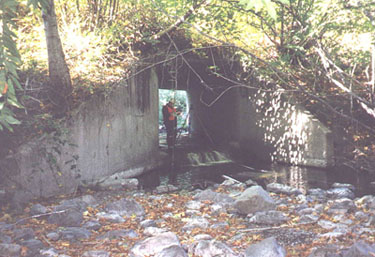
The objective of the project is to restore upstream fish passage on Indian Creek by removing a box culvert that served as a barrier to migrating juvenile and adult salmonids. Historically, coho salmon and steelhead inhabited Indian Creek upstream of the barrier and this stream may also constitute critical habitat for Chinook salmon. Replacement will afford access to 1.5 miles of high quality upstream spawning and rearing habitat consisting of cool water refugia, boulder/cobble-dominant channel, a dense riparian zone, and good flows in late summer.

The bridge installation will insure passage of high flows up to the 100-year storm and associated channel bedload and debris, will eliminate the potential for sediment delivery of 2,271 cubic yards from future culvert failure, and will allow passage of adult and juvenile salmonids at all flows.
RUBE CREEK at Cappell Road- (Completed) In July 2009, a situation was discovered on Cappell Road, crossing Rube Creek (tributary to the Klamath River), when investigation of road failures revealed that an eight-foot-diameter, 220-foot-long, steel multi-plate culvert had partially collapsed under 60 feet of road prism. It is likely that a tree entering the culvert tore a portion of the middle of the culvert away and saturated fill material washed out. Rather than a temporary repair that would necessitate future ground disturbance, the decision was made for a permanent replacement using County road funds.
 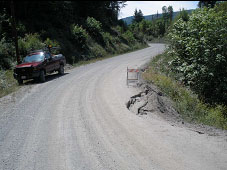
The collapsed culvert created a 6-ft. diameter sinkhole in the road shoulder due to high flows coming up through the failed section of culvert. The sinkhole is located 10 feet from the edge of the slipout (image above)
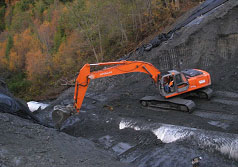 
(Left) New culvert construction – outlet side shown. (Right) Shows coconut fiber geotextile matting installed on downslope to control sediment and preserve slope stability. Upslope side contains straw wattles and mulch.
Frances Creek at Port Kenyon Road While the culvert at this crossing site seems adequate at first glance, it will require replacement. Due to an extreme amount of sediment in the culvert, backlogging and overflowing are common occurrences.
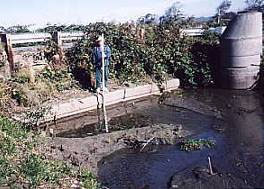 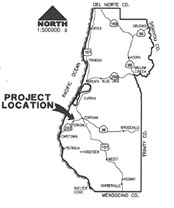
(Left) shows build up of sediments at culvert. (Right) Location of project near Fortuna.
 TELEGRAPH CREEK Dam and Triple Culvert Removal Project Design (in progress). A concrete dam located approximately 1.1 miles upstream from the Pacific Ocean represents a partial barrier to adult fish during winter flows up to 30 cubic feet per second (cfs) and a total barrier to fish passage during the dry season due to low flows of 1.0 cfs. TELEGRAPH CREEK Dam and Triple Culvert Removal Project Design (in progress). A concrete dam located approximately 1.1 miles upstream from the Pacific Ocean represents a partial barrier to adult fish during winter flows up to 30 cubic feet per second (cfs) and a total barrier to fish passage during the dry season due to low flows of 1.0 cfs.
The dam has been in place for over 40 years and is used as part of a water treatment plant intake that provides the community of Shelter Cove with 99% of it potable water supply. The project goal is removal of the dam and triple culvert on Telegraph Creek to re-establish fish passage and open an additional 4,900 feet of stream habitat for adult and juvenile salmonids. Full removal of the dam is contingent upon the District securing an alternative water supply.
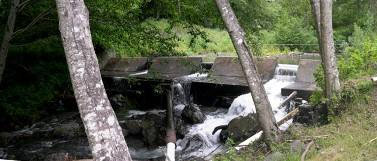
Dam on Telegraph Creek presents formidable barrier to fish migration

Triple-culvert on Telegraph Creek prevents fish migration
Back to news index
For more information contact us
The 5C Enews is funded through the Fisheries Restoration Grant Program through the CA Department of Fish and Wildlife
Image of Chinook Fry at top of page courtesy of USFWS & Dan Cox
| 